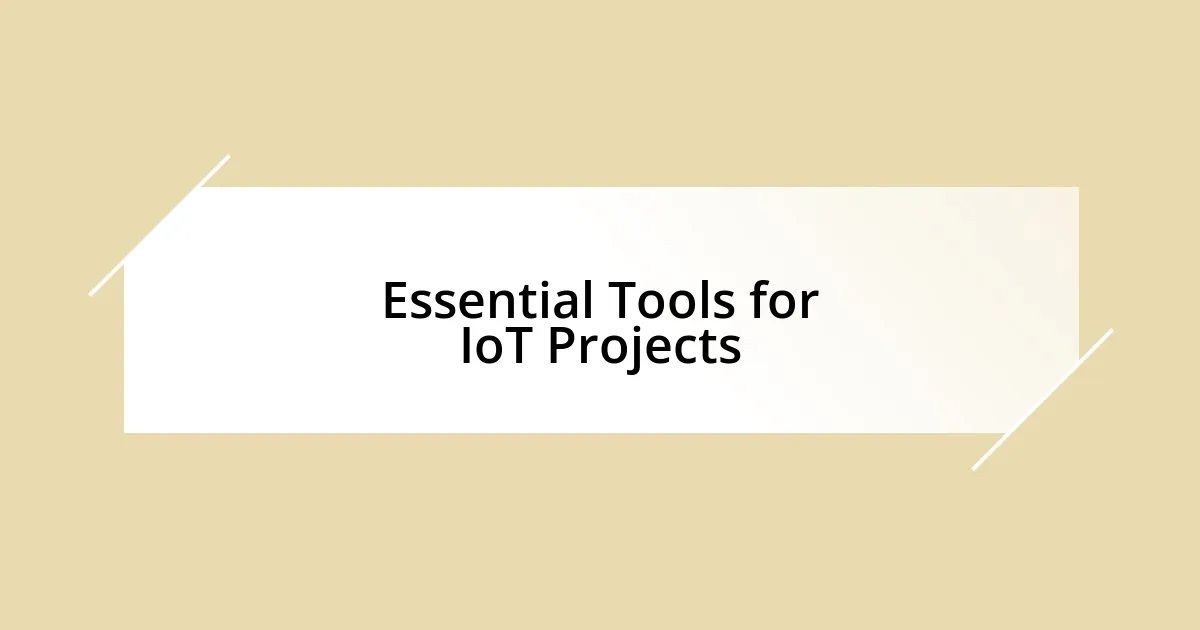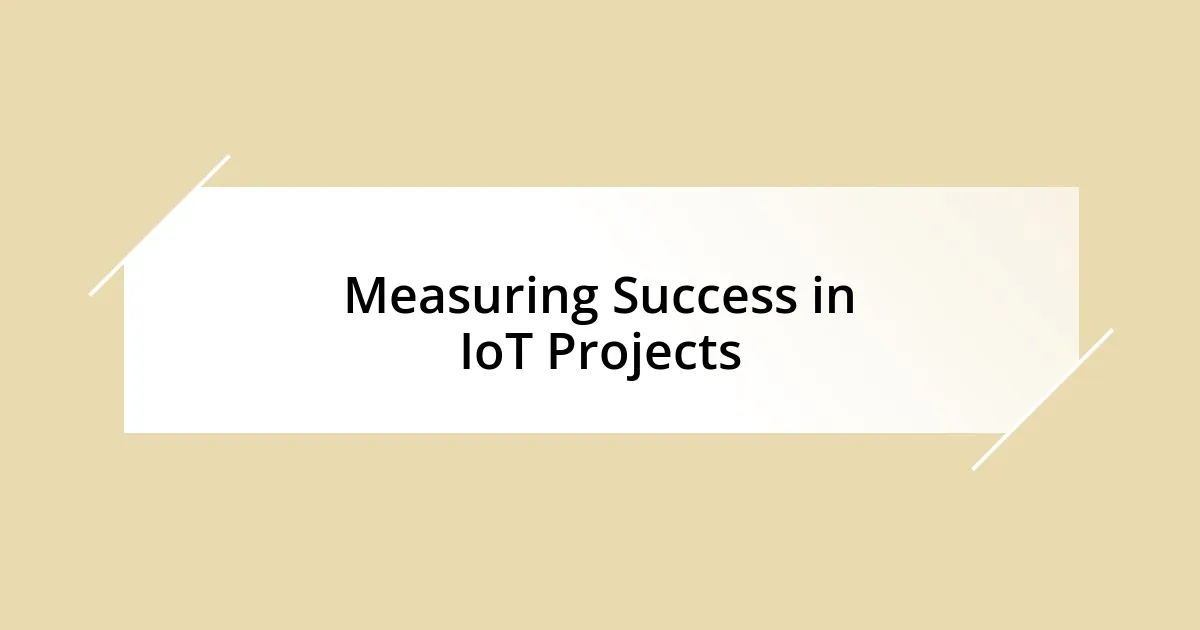Key takeaways:
- Connectivity and security are fundamental to IoT development, requiring attention to vulnerabilities and protections in design.
- Sensors, cloud infrastructure, and communication protocols are essential technologies that enhance IoT system functionality.
- Effective collaboration and clear communication among diverse team members foster innovation and streamline the development process.
- Success in IoT projects is best measured by user adoption rates, feedback loops, and overall return on investment (ROI) reflecting real-world impact.

Understanding IoT Development Basics
When I first dipped my toes into IoT development, it struck me how essential connectivity was—the foundation of everything we create. You’re essentially bringing devices to life, allowing them to communicate in ways that can make our lives easier and more efficient. Have you ever thought about how much data flows between devices daily? It’s mind-boggling!
In my journey, understanding the components of an IoT system became crucial. Each piece—from sensors to cloud services and user interfaces—plays a significant role in the overall functionality. There was a moment when I realized that even the simplest sensor—like a temperature gauge—could form part of a larger ecosystem, relaying critical information that could save energy or enhance safety. It made me appreciate the intricate design behind seemingly simple tasks.
Security is another basic yet often overlooked aspect of IoT development that I learned the hard way. Early in my projects, I neglected to consider vulnerabilities, only to find out later how exposed my systems were. This realization made me feel a mix of embarrassment and determination; I had to prioritize security in every project moving forward. It’s vital to ask yourself: How do I protect my devices and data from potential threats? Understanding these basics can build a strong foundation for innovation while safeguarding your creations.

Key Technologies in IoT
When diving into the world of IoT, I quickly discovered that sensors are the unsung heroes of this technology. They collect data from the environment, enabling us to monitor everything from temperature to motion. I remember the excitement I felt when I first integrated a humidity sensor into my home automation system. The moment I received real-time status updates, it felt like I had opened a window to a whole new world of opportunities.
Another critical technology is the cloud infrastructure, which serves as the backbone for storage and processing. I had a project where I had to evaluate different cloud platforms for scalability. The flexibility offered by cloud services allowed me to expand my device network effortlessly as my needs grew. It was a revelation—knowing that I could focus on my applications while the cloud handled storage and processing was like having a reliable partner by my side.
Of course, communication protocols play a pivotal role, determining how devices interact and share data. From MQTT to CoAP, each protocol has its unique strengths. I often pondered which one fit my project best. In one memorable instance, I opted for MQTT for a low-power application because it managed bandwidth brilliantly. This choice not only improved the system’s efficiency but also brought a wave of satisfaction, knowing I had made an informed decision.
| Technology | Function |
|---|---|
| Sensors | Collect data from the environment |
| Cloud Infrastructure | Stores and processes data |
| Communication Protocols | Facilitates interaction between devices |

Essential Tools for IoT Projects
When it comes to IoT development, having the right tools can make all the difference. I’ll never forget the first time I launched my project using an integrated development environment (IDE) specifically tailored for IoT. It streamlined my workflow, letting me focus more on coding rather than on configuration challenges. This hands-on experience reinforced my belief that the right tools can truly unlock creativity.
Here are some essential tools to consider for your IoT projects:
- Integrated Development Environments (IDEs): Streamline your coding and debugging processes.
- Prototyping Platforms: Arduino and Raspberry Pi can help quickly bring ideas to life.
- Data Visualization Tools: Grafana and Tableau enable effective presentation of your data insights.
- Device Management Software: Tools like Mender help in managing device updates and configurations seamlessly.
- Simulation Software: Programs like IoT-SIM assist in testing your setups without the need for physical devices.
In my early days, I often wished I had a solid analytics tool to make sense of the data coming from my devices. When I finally implemented a business intelligence tool, the clarity it provided was astonishing. I was able to spot trends and optimize processes, leading to a profound sense of accomplishment. Each tool contributes uniquely, and selecting the right combination based on your project’s needs can elevate your work to a new level.

Best Practices for IoT Security
When it comes to securing IoT devices, the approach needs to be multifaceted. One effective strategy I’ve adopted is implementing strong authentication mechanisms. I recall the first time I enabled two-factor authentication on my smart home devices; it was like sealing a vault with an unbreakable lock. It might seem like an extra step, but that minimal inconvenience brings unparalleled peace of mind, knowing that unauthorized access is significantly minimized.
Regularly updating device firmware is another best practice I can’t stress enough. In my earlier projects, I often overlooked this aspect until I encountered vulnerabilities in some devices due to outdated software. I remember the moment I decided to set up automated update notifications; it transformed my security posture. Imagine being able to focus on innovative developments instead of worrying about potential breaches—much more enjoyable, right?
Lastly, network segmentation has proven invaluable in my IoT security toolkit. I once set up a separate network for my smart devices, isolating them from my primary network where my sensitive data resided. It felt empowering to realize that even if one device were compromised, the most critical information remained secure. By making this simple change, I reduced the risk of a cascade of failures, and it reassured me that my devices could work together without jeopardizing my personal data.

Strategies for Effective Prototyping
When I first ventured into prototyping for my IoT projects, the importance of rapid iteration became crystal clear. I often found myself creating multiple versions of my designs just to see what worked best in practice. Have you ever tinkered with a concept and felt that thrill of discovery? That moment when a prototype functions better than anticipated is incredibly rewarding and fuels my passion for innovation.
To enhance my prototyping process, I learned to incorporate user feedback early and often. I vividly remember hosting a small demo session with friends where they interacted with my prototype. Their genuine excitement (and constructive criticism) provided insights I hadn’t even considered. It’s fascinating how the simplest interactions can uncover fundamental usability issues. Engaging users helps refine the design, ensuring it meets real-world needs.
A strategy that has served me well is to maintain a flexible mindset during the prototyping phase. In one instance, I designed a smart plant watering system that had numerous features planned out. However, as I tested it, I realized that users primarily wanted simplicity over complexity. The pivot I made to streamline functionality was a game-changer. How often do we resist change when a prototype seems “good enough”? Embracing input and being willing to adapt can consistently lead to better, more effective outcomes.

Collaborating in IoT Development
Collaboration in IoT development brings a dynamic energy that fuels creativity and innovation. I remember teaming up with a software engineer and a hardware specialist on a project that sought to connect smart home devices more seamlessly. The discussions we had proved invaluable. Each perspective revealed different considerations I might have overlooked, underscoring the magic that happens when diverse minds come together.
Working in teams also requires clear communication, which is something I learned the hard way. In a previous project, I assumed everyone was on the same page only to discover we had vastly different understandings of the project’s goals. After that, I initiated regular check-ins, and the clarity we gained not only improved our workflow but also deepened our relationships. Isn’t it ironic how clearer communication can forge stronger bonds among team members?
I often reflect on the collaborative tools that enhance these interactions. Platforms like GitHub have revolutionized how we share code and provide feedback. I recall how, during a hackathon, we used it to rapidly iterate on our ideas, transforming our codebase in real time. Watching our project evolve with everyone’s input felt electric. Don’t you think time spent collaborating on the right platforms can amplify creativity and streamline the development process? It has certainly done wonders for me.

Measuring Success in IoT Projects
Measuring success in IoT projects often feels like navigating a complex maze. One effective metric I’ve found is user adoption rates. For instance, when I launched a smart thermostat, I was thrilled to see that within weeks, user engagement skyrocketed. It was a clear indicator that not only had I developed a useful product, but it also resonated with people’s daily lives. How gratifying is it to know that what you’ve created is genuinely making a difference?
Another key aspect for me has been analyzing the feedback loop from users post-deployment. I vividly remember the moment I received an email from a user expressing their enthusiasm about new features I hadn’t anticipated while designing. Hearing how my device simplified their routines reinforced the idea that effective IoT solutions truly prioritize the user’s experience. Isn’t it rewarding when success is measured not just in numbers but in the joy and ease you bring to others?
Finally, I believe that evaluating the overall return on investment (ROI) is crucial in the IoT space. After deploying a smart agricultural system, I calculated the savings in water and energy for farmers who adopted my technology. The numbers were enlightening; but what touched me most was the stories of families being able to sustain their farms better. Isn’t it compelling when success extends beyond profit margins to positively impact lives and communities?














